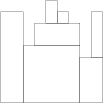For example, given
A = [3, 8, 9, 7, 6] K = 3
the function should return [9, 7, 6, 3, 8]. Three rotations were made:
[3, 8, 9, 7, 6] -> [6, 3, 8, 9, 7] [6, 3, 8, 9, 7] -> [7, 6, 3, 8, 9] [7, 6, 3, 8, 9] -> [9, 7, 6, 3, 8]
For another example, given
A = [0, 0, 0] K = 1
the function should return [0, 0, 0]
Given
A = [1, 2, 3, 4] K = 4
the function should return [1, 2, 3, 4]
설명:
A 의 배열을 K 만큼 우측 으로 이동했을시 나오는 A를 반환하면 된다.
class Solution { public int[] solution(int[] A, int K) { // write your code in Java SE 8 int[] rotaionA = new int[A.length]; for(int i =0;i< A.length;i++){ rotaionA[ (i+K) % A.length ] = A[i]; } return rotaionA; } }
'프로그래밍 > 알고리즘' 카테고리의 다른 글
| 시간 복잡도 (0) | 2018.04.21 |
|---|---|
| [Codility] CountSemiprimes (0) | 2018.04.21 |
| [Codility] Stone wall (0) | 2018.04.15 |
| [Codility] Binary Gap 알고리즘 (0) | 2018.04.14 |
| 알고리즘 공부 사이트 (0) | 2017.01.27 |







